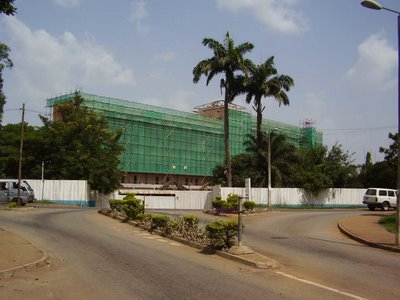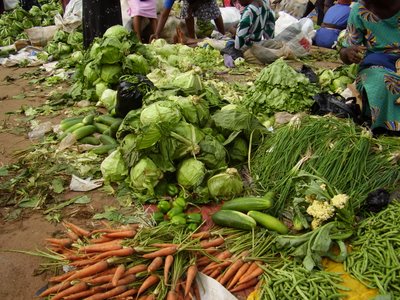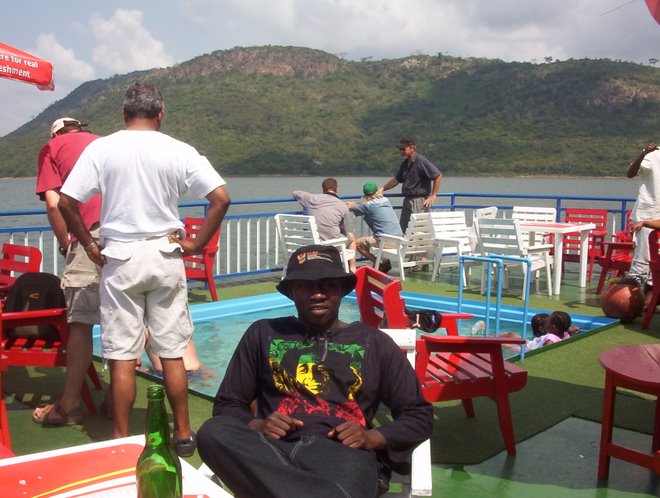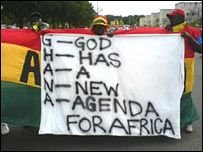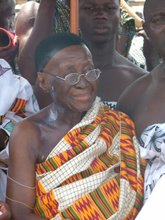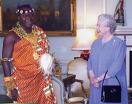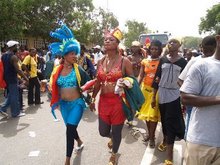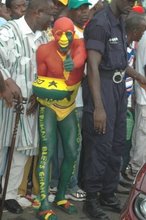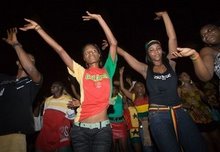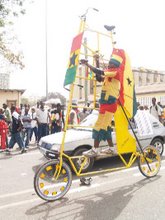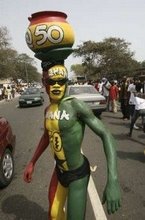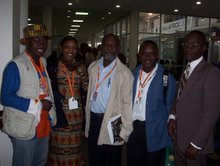Thursday, November 23, 2006
Wednesday, November 15, 2006
OLD SKUUL REUNION IN KUMASI
 (Picture shows left - Asanka Boyoyo, middle- Otwinoko, right- Kofi Adu Domfeh all of Luv FM. This was taken at the old students reunion held at the Ridge Park.
(Picture shows left - Asanka Boyoyo, middle- Otwinoko, right- Kofi Adu Domfeh all of Luv FM. This was taken at the old students reunion held at the Ridge Park.
If the maiden edition of the Old Schools Reunion in
Most of the old students who gathered at the event sang their schools anthem and the popular “jama” songs during their stay in school.
The participating old students associations were eager and determined to outdo their counterparts in almost every event which included High Jump, 50-metre hurdles, 50- metre dash, gari soaking, a five-aside football gala, table tennis, tag of war, “jama” and dancing competitions. (Picture Shows: Lord Kenya on stage entertaining the crowd)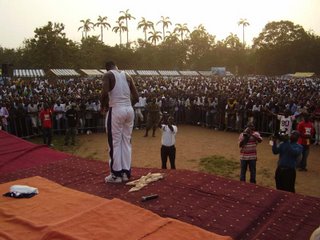 The Rap Heavy Weight Champion, as he describes himself, Lord
The Rap Heavy Weight Champion, as he describes himself, Lord
Students of the Kwame Nkrumah University of Science and Technology from Unity and Katanga Halls respectively, who appeared on the scene in the nude, also engaged in stone and bottle throwing at each other during the “jama” competition, thus resulting in some injuries which brought proceedings to a temporary halt around mid-day.
But that was short-lived when the five-aside football gala was ushered in.
An exciting aspect of the whole event was the side attraction which saw a coterie of guys gathering at various spots to admire ladies who were in dresses that exposed parts of their bodies. There was also shortage of alcoholic drinks and the organisers had to work out quickly to replenish their stocks.
Many were those who met their old-time school friends whom they never met after school. Prior to the games on Saturday and in studio interactions with various old students associations in the weeks leading to the games, we witnessed scintillating performances from old school folks who seemed not to have forgotten their secondary school days. (Picture shows Anita Akua Kyerewaa of Luv FM) Old students of
Old students of
Kumasi High came first in the 50-metre hurdles, followed by the
Kumasi High again came first In the 50-metre dash, followed by 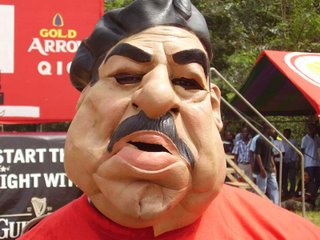
Posted by
Enoch Darfah Frimpong
at
4:17 pm
0
comments
![]()
Wednesday, November 08, 2006
Kejetia Lorry Terminal deteriorates
Picture shows an aerial view of the Kejetia Lorry Terminal
Kejetia is one name so dear to the hearts of residents in the
A number of the pavement blocks have been dented and there seem to be no plan to get the deteriorated pavement blocks rehabilitated inspite of numerous calls by the public to get them repaired.
The situation becomes worse during rainy periods as pedestrians have to meander through floods to board and alight from vehicles.
Big buses, especially the double decker ones belonging to the Metro Mass Transit (MMT) move about in dislocated pavement blocks under dangerous conditions.
Picture shows dislocated pavement blocks at the Kejetia Lorry Terminal with vehicles trying to move through stagnant waters at the place.
In giving out the management of the lorry terminal to a private company, Mr. Maxwell Kofi Jumah, the then Metropolitan Chief Executive of the Kumasi Metropolitan Assembly (KMA) explained that the management of the lorry terminal was going to be on contract basis and gave a long list of what was to be expected at Kejetia.
This included the registering of special potters at the place and clothing them for easy identification, a thorough cleaning and monitoring of the infrastructure at the place as well as routine maintenance of the infrastructure.
The managers were to ensure that hawking was not entertained at the place but the direct opposite of what was outlined is being experienced at the place currently.
Employees of managers of the place, F. D. Freko, allegedly take bribes from certain hawkers and allow them to ply their trade at the place.
Aside the deteriorating nature of the place is the present crop of vehicular congestion at the place.
The government decided to rehabilitate the lorry terminal with the intention to find a lasting solution to the problem of the heavy pedestrian population, which competed with vehicular traffic resulting in the confusion in the area as a result of the heavy “go-slow” that engulfed the area then and sprang to the centre of
The idea was to find a solution to the problem once and for all whilst at the same time maintain the natural beauty of the area, thereby separate the market, and the cars from the pedestrian.
It looks as if the problem that existed at the place earlier on is being allowed to repeat itself with the construction of more market stores at the place thus limiting parking and loading points for vehicles.
There is congestion all over the place at Kejetia presently as vehicles struggle to get access to the terminal, which temporarily block traffic to
Indeed no project had ever attracted so much controversy in the history of
A clause in the agreement at the time of the rehabilitation debarred the contractor from talking about the project except with the client.
Officials at the Urban Roads Department, which was the client, at that time, referred anyone who needed information on the project to
It was therefore not surprising that many people read several interpretations into the project until the Roads and Transport Ministry finally intervened and went public.
In its explanation, the Ministry pointed out that the project was in phases- the Kejetia Development Project proper and the Kejetia Lorry Terminal.
The Kejetia Development Project involved the re-alignment of the roads to and from Kejetia, which re-directed vehicular traffic from the roundabout as well as the development of an infrastructure at the Central Market.
Messrs Limex Bau Limited, a German company, executed the Kejetia Development project proper while Messrs G. K. Appiah handled the Kejetia Lorry Terminal project, which involved the rehabilitation of the lorry park.
The two projects were therefore considered as one, which was going to help
Under the terminal project no provision was made for shops in the original plan of 1990.
The design included the reconstruction of the lorry park, passenger sheds, offices, a plaza area around the roundabout with pedestrian alleys and shopping areas for the sale of artifacts.
But what do we see today? New developments and construction of market stores are springing up all over the place.
It would be recalled that a controversy ensued in 1999 between the Kejetia Traders Association who tried to construct market stores at the place and the
The controversy bordered on the authorisation by Nana Akwasi Agyemang, the then Metropolitan Chief Executive for the construction of stores by the traders association.
The GPRTU in their argument said the lorry park was already too small to accommodate the heavy vehicular population in
The KMA later demolished and prevented the traders association from constructing an 84-shop complex at the terminal following the GPRTU’s objection, claiming that the building was being constructed in the middle of the terminal and would therefore reduce parking spaces.
The KMA stopped the project after it had given the permission for the construction of the shops for displaced members of the Kejetia Traders Association who were affected by the Kejetia project.
The Regional Security Council (REGSEC) later ruled that the building was not properly sited and that it should be demolished and a suitable place allocated to the Association for the construction of a new building.
But it looks as if lessons from the controversies that ensued in 1999 over the construction of the market stores at Kejetia have soon been forgotten.
Picture shows dislocated pavement blocks at the Kejetia Lorry Terminal with vehicles trying to move through stagnant waters at the place
A visit to the area reveals that places designed for taxi ranks have been taken over by stores, which has contributed to limiting parking and loading points for vehicles.
The Kejetia Traders Association in 2004 repeated a call for the Kumasi Metropolitan Assembly to explain the rational behind the decision to allow a private developer to construct market stores at the terminal after the Assembly had demolished and prevented the association from putting up similar stores at the terminal in 1999 with the excuse that the stores was going to limit parking spaces at the place.
Surprisingly, there was no response to that effect and the building project, is almost complete, standing on the same foundation, which was ruled as unfit for construction earlier on.
This is only one of the constructions going on at the place, apart from other ones, which have already been completed.
Before the project was implemented various studies were done by the Building Research and Road Institute (BRRI). Several designs, which included the construction of flyovers (interchange), were also considered.
The study by the BRRI indicated that the use of flyover at the area was good, but it was going to be expensive to construct hence the idea of flyover was abandoned.
The final basis for the selection of the present design (without a flyover) was to find optimal solution to the problem of pedestrian and vehicular congestion at the place thereby maximising the use of the available space to improve pedestrian and vehicular movement in view of the limited resources.
Various options were therefore put before the financiers of the project who were the World Bank and OPEC Fund and the present design was selected based on availability of resources.
Traffic from Adum through the then roundabout to Ashanti New Town and Manhyia were diverted through the Children’s Hospital area and the Zoo with the aim to help reduce congestion.
It was later announced that even though the project was being executed nothing prevents the construction of flyovers when funds were available, but how can that be done, with the present market stores construction if there is a decision to construct flyovers.
Due to the central location of
Studies by the Building and Road Research Institute (BRRI) in 1999 showed that the Kejetia area was the busiest spot in the whole of
According to the studies, as many as 13,000 people shuttle between the Kejetia Lorry park and the Mampong road in an hour whilst 18,000 cross over from the lorry park to the central market.
This heavy pedestrian population competed with vehicular traffic resulting in the confusion in the area, which accounted for heavy “go-slow” in the centre of
The intention of government was therefore to find a solution to that problem once and for all whilst at the same time maintain the natural beauty of the area, thereby separate the market, and the cars from the pedestrian.
It looks as if the problem that existed at the place earlier on is being allowed to repeat itself with the construction of more market stores at the place.
If nothing was done about it, the problem would be compounded and it would mean the more market shops, the more human congestion at the place.
Are we to wait and observe our cherished Kejetia lorry terminal deteriorate and get back to the bad state in which it was before the rehabilitation or has the focus for reducing vehicular traffic and human congestion at the place changed?
Posted by
Enoch Darfah Frimpong
at
9:03 am
1 comments
![]()
Labels Kejetia
Tuesday, November 07, 2006
MESSING UP WATER BODIES BIG TIME IN KUMASI
The continued pollution of water bodies in the Kumasi metropolis has been a major problem environmentalists have been trying to uproot.
There has been a massive pollution of water bodies in the Kumasi metropolis in the last few years as people dump filth and human excreta into rivers haphazardly at all areas in the metropolis.
Some have even connected their sewerage pipes directly into rivers where excreta from their homes are directly deposited into the rivers which drain into the Owabi and Barekese dams, which provides water supply for Kumasi and other surrounding areas.
Although the Ghana Water Company Limited (GWCL) and the Environmental Health Department of the Kumasi Metropolitan Assembly (KMA) have on numerous occasions embarked on campaigns to call on people to desist from such activities, the practice seems to be on the increase.
Save Our Waters Ghana (SOWG), a non governmental organisation in Kumasi has taken a giant step in fighting the canker but its efforts would come to nothing if residents don’t change their attitude towards pollution.
Ghana has been highlighted to become one of the water stress countries in Africa in a few years to come. The recent rationing of pipe borne water by the Ghana Water Company Limited (GWCL), felling of trees along river banks and destruction of forest reserves at dam catchments, developing water bodies for settlements, dumping of refuse at the catchments of water supply and outbreak of water related diseases are all issues which point to a near future water stress in Ghana.
Water shortage causes a lot of problems ranging from domestic, industrial and in government circles as well.
In view of this, it is about time that people became conscious about saving water bodies in order to help avert any water crisis in future.
Posted by
Enoch Darfah Frimpong
at
9:25 am
0
comments
![]()
Vegetables on ground for sale
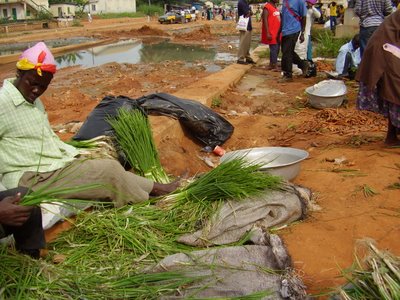
Picture shows market women selling vegetables and fruits on the bare ground and close to stagnant water and gutters infested with filth at the Dunkirk area in Kumasi near the Asafo Market-UTC Interchange, which is under construction.
This picture depicts an example of conditions under which food stuffs especially vegetables and fruits, most of which are eaten raw are sold on the bare ground in market places across the country.
There have been numerous calls from members of the public for market women to desist from such practices but the calls seem to be falling on deaf ears.
At a recent matriculation ceremony of the Kwadaso Agricultural College in Kumasi, the Principal of the College, Mr Anthony Appiah proposed that District Assemblies should enact bye-laws to compel vegetables and fruit sellers to at least sell on tables.
Such, a move he said would help make vegetables and fruits hygienic for human consumption.
Posted by
Enoch Darfah Frimpong
at
9:01 am
0
comments
![]()
Monday, November 06, 2006
Asafo Market-UTC Interchange Project in Kumasi
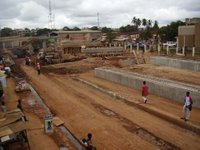
Posted by
Enoch Darfah Frimpong
at
1:31 pm
0
comments
![]()
Welcome to Kumasi

Welcome. Hence I shall be writing about
developments in Kumasi, the second capital city of
Ghana and otherwise referred to as the Garden City of
Africa. I would also try to provide pictures on the
developments as well as feed you on issues in the metropolis. Kumasi is gradually
expanding and a lot more suburbs are spranging up.
Posted by
Enoch Darfah Frimpong
at
10:45 am
0
comments
![]()
Friday, November 03, 2006
THE HISTORY OF KUMASI

Kumasi, the capital city of the Ashanti region is located in the rain forest region of Ghana and is popularly known as "The Garden City" because of its various species of flowers and plants.It is the second-largest city in Ghana, located in the south-central part of the country, about 250 km from Accra.
Queen Elizabeth II of England gave Kumasi the name Garden City of Africa when she visited the area in the 1960s because of the varied plant life in the area.

While the terrain surrounding Kumasi is relatively flat, the countryside is lush with tropical vegetation.
With over 2.5 million citizens, the city spans a radius of about 18 to 20 miles.
Picture shows: Mr E. A. Owusu Ansah (in tie), current Ashanti Regional Minister in an interaction with pressmen a month after assuming office as Ashanti Regional Minister. On the extreme left is Nana Yaw Osei, Vice Chairman, Ashanti GJA, on the Minister's left is Enoch (myself) and Adu Poku of GNA-Kumasi
The largest ethnic group is the Asantes, but other ethnic groups are growing in size.
Approximately 80 percent of Christians and 20 percent Muslims, with a smaller number of adherents to traditional beliefs.
The city rose to prominence in 1695 when it became capital of the Asante Confederacy due to the activities of the then ruler, King Osei Tutu I.
King Osei Tutu I was known as the Kumasihene and he served as ruler of the Asante Confederacy.
Parts of the city, including the Royal Palace, known as Manhyia were destroyed by British troops in the Fourth Anglo-Ashanti War of 1874.
A relatively young city, Kumasi was founded in the early 19th century by King Osei Tutu. The king named the city after the Kum tree, which he planted as a symbol of victory for the Asante Empire over the British. The Asante region has been independent since 1875 even though Ghana itself only declared independence in 1957. A descendant of King Osei Tutu, Nana Osei Tutu II, is King of the Asantes today, receiving allegiance from the people within the democracy of Ghana. He is said to be the richest King on Africa's West Coast.The King resides in Kumasi, and his home, the Manhyia Palace, is one of the city's most spectacular sights. The city holds an important place in the history of the Asante people as legend has it that a golden stool in the palace descended from heaven, and Okomfo Anokye, an ancient priest received the Golden stool, which signifies an embodiment of the soul of the Asante nation.
Near the palace grounds a copper sword was said to have been driven into the ground by Okomfo Anokye, which no one has been able to remove by any means.
Kumasi remains a royal city, the role of the King has been mainly symbolic. Due to large gold deposits that have been mined in the area, Kumasi has been among the wealthier cities in Ghana. Today's major exports are timber and cocoa. Kumasi has 50 percent of the timber industry in Ghana, with more than 4,000 employed in the business.
Trade, commerce, farming and mining are leading industries in Kumasi. In addition, its region boasts a rich cultural heritage particularly evident in smaller surrounding towns. Other riches abound, with wealth derived from substantial gold deposits and agricultural products. Cocoa and high-quality hardwood (timber) are other major exports
Features of the city include the large Kumasi Central Market, Fort Kumasi (built by the British in 1896 to replace an Asante fort and now a museum) and the Kumasi Hat Museum (Built by the late Nana Kofi Genfi.

Along with history and legend, Kumasi is a fast-growing, contemporary city. It is filled with avid sports enthusiasts who are especially proud of the soccer team, the Kumasi Asanti Kotoko. The team has won numerous national and continental awards
Kumasi is also home to a zoo, the Kumasi Zoological Gardens, which is next to the Centre of National Culture (CNC), the Kwame Nkrumah University of Science and Technology of Ghana (formerly the Kumasi College of Technology).
The Kumasi area has one public hospital (Komfo Anokye Teaching Hospital, 736 beds), five public clinics and 57 private clinics (1992 figures).
The city's most famous child is the current general-secretary of the United Nations, Kofi Annan. The local football (soccer) team, the Kumasi Asante Kotoko has won several national and continental awards. The Kumasi Sports Stadium was built in 1959 and renovated in 1978 with a seating capacity of 80,000 the largest in the country. It is currently undergoing another renovation in readiness for CAN 2008, which is being hosted in Ghana.
Kumasi is home to numerous educational institutions, including the University of Science and Technology, one of Ghana's premiere facilities of higher learning. English is the official language of Kumasi, and its native language is Asanti (TWI).
Posted by
Enoch Darfah Frimpong
at
10:56 am
0
comments
![]()



